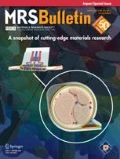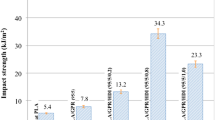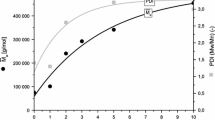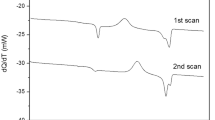Abstract
The backbones of biodegradable and bioderived polymers often contain chemical bonds, such as ester and amide that are susceptible to hydrolysis. Here, we show that hydrolysis causes a transition from ductile to brittle fracture in poly(lactic acid) (PLA). Submerged in an aqueous solution and bearing a load, a sample with a precrack undergoes extensive plastic deformation when the crack grows fast, but negligible plastic deformation when the crack grows slowly. In the former, the ductile fracture creates rough and porous crack surfaces, indicating that polymer chains slip before scission. In the latter, the brittle fracture creates flat crack surfaces, indicating that polymer chains slip negligibly before scission. Furthermore, at a low load and over a broad range of pH, the velocity of a crack in PLA correlates with the rate of hydrolysis of lactic acid oligomers. Taken together, these observations demonstrate that PLA suffers hydrolytic embrittlement. The phenomenon should be taken into account in the design of—and with—biodegradable and bioderived polymers.
Impact statement
In thermoplastics of high molecular weights, repeat units form long polymer chains by chemical bonds, and the long polymer chains form solids by physical interactions. Between neighboring repeat units, the chemical bonds are commonly much stronger than the physical interactions. Polymer chains slip extensively before scission in ductile fracture, but slip negligibly before scission in brittle fracture. In biodegradable and bioderived thermoplastics, repeat units often link by chemical bonds susceptible to hydrolysis. Here, we show that hydrolysis embrittles a leading bioderived thermoplastic, poly(lactic acid). Even a small load exposes a crack tip to water molecules from the environment, hydrolyzing ester bonds and breaking chains with negligible chain slip. The material has a toughness above 104 J/m2. However, submerged in an aqueous solution, the material can grow a crack at an energy release rate as low as 1 J/m2. Hydrolytic embrittlement should be investigated for biodegradable and bioderived polymers under development for health care and sustainability.
Graphical abstract

Similar content being viewed by others
References
R.E. Drumright, P.R. Gruber, D.E. Henton, Polylactic acid technology. Adv. Mater. 12, 1841 (2000)
M.S. Singhvi, S.S. Zinjarde, D.V. Gokhale, Polylactic acid: Synthesis and biomedical applications. J. Appl. Microbiol. 127, 1612 (2019)
A. Chamas, H. Moon, J. Zheng, Y. Qiu, T. Tabassum, J.H. Jang, M. Abu-Omar, S.L. Scott, S. Suh, Degradation rates of plastics in the environment. ACS Sustain. Chem. Eng. 8, 3494 (2020)
G. Kale, R. Auras, S.P. Singh, Degradation of commercial biodegradable packages under real composting and ambient exposure conditions. J. Polym. Environ. 14, 317 (2006)
R. Auras, B. Harte, S. Selke, An overview of polylactides as packaging materials. Macromol. Biosci. 4, 835 (2004)
J. Muller, C. González-Martínez, A. Chiralt, Combination of poly(lactic) acid and starch for biodegradable food packaging. Materials (Basel) 10(8), 952 (2017)
K. Hamad, M. Kaseem, H.W. Yang, F. Deri, Y.G. Ko, Properties and medical applications of polylactic acid: A review. Express Polym. Lett. 9, 435 (2015)
D. da Silva, M. Kaduri, M. Poley, O. Adir, N. Krinsky, J. Shainsky-Roitman, A. Schroeder, Biocompatibility, biodegradation and excretion of polylactic acid (PLA) in medical implants and theranostic systems. Chem. Eng. J. 340, 9 (2018)
Y. Song, Y. Li, W. Song, K. Yee, K.-Y. Lee, V.L. Tagarielli, Measurements of the mechanical response of unidirectional 3D-printed PLA. Mater. Des. 123, 154 (2017)
T.D. Ngo, A. Kashani, G. Imbalzano, K.T. Nguyen, D. Hui, Additive manufacturing (3D printing): A review of materials, methods, applications and challenges. Compos. B Eng. 143, 172 (2018)
X. Yang, J. Steck, J. Yang, Y. Wang, Z. Suo, Degradable plastics are vulnerable to cracks. Engineering 7, 624 (2021)
C. Chu, N. Campbell, Scanning electron microscopic study of the hydrolytic degradation of poly (glycolic acid) suture. J. Biomed. Mater. Res. 16, 417 (1982)
R. Chandra, R. Rustgi, Biodegradable polymers. Prog. Polym. Sci. 23, 1273 (1998)
Z. Wang, M.S. Ganewatta, C. Tang, Sustainable polymers from biomass: Bridging chemistry with materials and processing. Prog. Polym. Sci. 101, 101197 (2020)
C. Hepburn, Polyurethane Elastomers (Springer, New York, 2012)
A. Atrens, N. Winzer, W. Dietzel, Stress corrosion cracking of magnesium alloys. Adv. Eng. Mater. 13, 11(2011). https://doi.org/10.1002/adem.200900287
K. Sieradzki, R.C. Newman, Brittle behavior of ductile metals during stress-corrosion cracking. Philos. Mag. A 51, 95 (1985). https://doi.org/10.1080/01418618508245272
E. Orowan, The fatigue of glass under stress. Nature 154, 341 (1944). https://doi.org/10.1038/154341a0
S.M. Wiederhorn, Moisture assisted crack growth in ceramics. Int. J. Fract. Mech. 4, 171 (1968)
M. Ciccotti, Stress-corrosion mechanisms in silicate glasses. J. Phys. D Appl. Phys. 42(21), 214006 (2009). https://doi.org/10.1088/0022-3727/42/21/214006
M. Braden, A.N. Gent, The attack of ozone on stretched rubber vulcanizates. I. The rate of cut growth. J. Appl. Polym. Sci. 3, 90 (1960). https://doi.org/10.1002/app.1960.070030713
M. Braden, A.N. Gent, The attack of ozone on stretched rubber vulcanizates. II. Conditions for cut growth. J. Appl. Polym. Sci. 3, 100 (1960)
M. Shi, J. Steck, X. Yang, G. Zhang, J. Yin, Z. Suo, Cracks outrun erosion in degradable polymers. Extreme Mech. Lett. 40, 100978 (2020). https://doi.org/10.1016/j.eml.2020.100978
X. Yang, J. Yang, L. Chen, Z. Suo, Hydrolytic crack in a rubbery network. Extreme Mech. Lett. 31, 100531 (2019). https://doi.org/10.1016/j.eml.2019.100531
Q. Jiao, M. Shi, T. Yin, Z. Suo, J.J. Vlassak, Composites retard hydrolytic crack growth. Extreme Mech. Lett. 48, 101433 (2021)
T. Baumberger, O. Ronsin, Environmental control of crack propagation in polymer hydrogels. Mech. Soft Mater. 2, 14 (2020). https://doi.org/10.1007/s42558-020-00027-2
P. Prentice, The influence of molecular weight on the fracture of thermoplastic glassy polymers. J. Mater. Sci. 20, 1445 (1985)
J. Zhao, L. Lu, T. Rabczuk, The tensile and shear failure behavior dependence on chain length and temperature in amorphous polymers. Comput. Mater. Sci. 96, 567 (2015)
J. Jancar, E. Fekete, P. Hornsby, J. Jancar, B. Pukánszky, R. Rothon, Mineral Fillers in Thermoplastics I: Raw Materials and Processing (Springer, New York, 1999)
S.N. Zhurkov, V.E. Korsukov, Atomic mechanism of fracture of solid polymers. J. Polym. Sci. Polym. Phys. Ed. 12, 385 (1974)
S.-Q. Wang, S. Cheng, P. Lin, X. Li, A phenomenological molecular model for yielding and brittle-ductile transition of polymer glasses. J. Chem. Phys. 141, 094905 (2014)
I. Vroman, L. Tighzert, Biodegradable polymers. Materials (Basel) 2(2), 307 (2009)
G.H. Yew, A.M. Yusof, Z.M. Ishak, U.S. Ishiaku, Water absorption and enzymatic degradation of poly (lactic acid)/rice starch composites. Polym. Degrad. Stab. 90, 488 (2005)
E.W. Fischer, H.J. Sterzel, G. Wegner, Investigation of the structure of solution grown crystals of lactide copolymers by means of chemical reactions. Kolloid-Z. Z. Polym. 251, 980 (1973)
T. Tábi, S. Hajba, J.G. Kovács, Effect of crystalline forms (α′ and α) of poly (lactic acid) on its mechanical, thermo-mechanical, heat deflection temperature and creep properties. Eur. Polym. J. 82, 232 (2016)
A. Pawlak, A. Galeski, A. Rozanski, Cavitation during deformation of semicrystalline polymers. Prog. Polym. Sci. 39, 921 (2014)
H. Tada, P.C. Paris, G.R. Irwin, The Stress Analysis of Cracks Handbook (Del Research Corporation, Hellertown, 1973), p. 53
G.R. Irwin, Analysis of stresses and strains near the end of a crack traversing a plate. J. Appl. Mech. 24, 361 (1957)
T. Baumberger, O. Ronsin, Cooperative effect of stress and ion displacement on the dynamics of cross-link unzipping and rupture of alginate gels. Biomacromolecules 11, 1571 (2010). https://doi.org/10.1021/bm1002015
S.M. Wiederhorn, Influence of water vapor on crack propagation in soda-lime glass. J. Am. Ceram. Soc. 50, 407 (1967). https://doi.org/10.1111/j.1151-2916.1967.tb15145.x
S.J. de Jong, E.R. Arias, D.T.S. Rijkers, C.F. van Nostrum, J.J. Kettenes-van den Bosch, W.E. Hennink, New insights into the hydrolytic degradation of poly(lactic acid): Participation of the alcohol terminus. Polymer 42(7), 2795 (2001)
Acknowledgments
This research was supported by the Harvard University MRSEC, which is funded by the National Science Foundation under Grant DMR-2011754. Part of this work was performed at the Center for Nanoscale Systems (CNS), which is supported by the National Science Foundation under Grant ECS 1541959. M.S. and T.Y. were visiting students at Harvard University supported by the China Scholarship Council. Q.J. acknowledges H. Yang’s assistance in sample preparation.
Author information
Authors and Affiliations
Corresponding authors
Supplementary Information
Below is the link to the electronic supplementary material.
Supplementary file1 (MP4 253963 kb)
Supplementary file2 (MP4 65435 kb)
Rights and permissions
About this article
Cite this article
Shi, M., Jiao, Q., Yin, T. et al. Hydrolysis embrittles poly(lactic acid). MRS Bulletin 48, 45–55 (2023). https://doi.org/10.1557/s43577-022-00368-5
Accepted:
Published:
Issue Date:
DOI: https://doi.org/10.1557/s43577-022-00368-5












